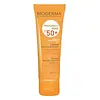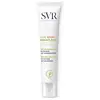What's inside
What's inside
 Key Ingredients
Key Ingredients

 Benefits
Benefits

 Concerns
Concerns

 Ingredients Side-by-side
Ingredients Side-by-side

Water
Skin ConditioningDicaprylyl Carbonate
EmollientOctocrylene
UV AbsorberMethylene Bis-Benzotriazolyl Tetramethylbutylphenol
UV FilterButyl Methoxydibenzoylmethane
UV AbsorberBis-Ethylhexyloxyphenol Methoxyphenyl Triazine
Skin ConditioningCyclomethicone
EmollientC20-22 Alkyl Phosphate
EmulsifyingGlyceryl Stearate
EmollientPEG-100 Stearate
Ectoin
Skin ConditioningMannitol
HumectantXylitol
HumectantRhamnose
HumectantFructooligosaccharides
HumectantLaminaria Ochroleuca Extract
Skin ConditioningC20-22 Alcohols
Emulsion StabilisingDecyl Glucoside
CleansingHydroxyethyl Acrylate/Sodium Acryloyldimethyl Taurate Copolymer
Emulsion StabilisingPentylene Glycol
Skin ConditioningXanthan Gum
EmulsifyingPropylene Glycol
HumectantCitric Acid
BufferingCaprylic/Capric Triglyceride
MaskingDisodium EDTA
Sodium Hydroxide
BufferingChlorphenesin
AntimicrobialPhenoxyethanol
PreservativeWater, Dicaprylyl Carbonate, Octocrylene, Methylene Bis-Benzotriazolyl Tetramethylbutylphenol, Butyl Methoxydibenzoylmethane, Bis-Ethylhexyloxyphenol Methoxyphenyl Triazine, Cyclomethicone, C20-22 Alkyl Phosphate, Glyceryl Stearate, PEG-100 Stearate, Ectoin, Mannitol, Xylitol, Rhamnose, Fructooligosaccharides, Laminaria Ochroleuca Extract, C20-22 Alcohols, Decyl Glucoside, Hydroxyethyl Acrylate/Sodium Acryloyldimethyl Taurate Copolymer, Pentylene Glycol, Xanthan Gum, Propylene Glycol, Citric Acid, Caprylic/Capric Triglyceride, Disodium EDTA, Sodium Hydroxide, Chlorphenesin, Phenoxyethanol
Water
Skin ConditioningSilica
AbrasiveDiethylamino Hydroxybenzoyl Hexyl Benzoate
UV FilterDiisopropyl Adipate
EmollientEthylhexyl Triazone
UV AbsorberBeheneth-25
CleansingIsononyl Isononanoate
EmollientNiacinamide
SmoothingBis-Ethylhexyloxyphenol Methoxyphenyl Triazine
Skin ConditioningGlycerin
HumectantC12-15 Alkyl Benzoate
AntimicrobialC15-19 Alkane
SolventDiethylhexyl Butamido Triazone
UV AbsorberGlyceryl Stearate Citrate
EmollientAcrylates/C12-22 Alkyl Methacrylate Copolymer
Pentylene Glycol
Skin ConditioningButylene Glycol
HumectantSalicylic Acid
Masking1,2-Hexanediol
Skin ConditioningCaprylyl Glycol
EmollientParfum
MaskingArginine
MaskingCoco-Glucoside
CleansingXanthan Gum
EmulsifyingTocopherol
AntioxidantSodium Hydroxide
BufferingDisodium Lauryl Sulfosuccinate
CleansingGlycine Soja Oil
EmollientLecithin
EmollientSarcosine
Skin ConditioningLepidium Sativum Sprout Extract
Skin ConditioningWater, Silica, Diethylamino Hydroxybenzoyl Hexyl Benzoate, Diisopropyl Adipate, Ethylhexyl Triazone, Beheneth-25, Isononyl Isononanoate, Niacinamide, Bis-Ethylhexyloxyphenol Methoxyphenyl Triazine, Glycerin, C12-15 Alkyl Benzoate, C15-19 Alkane, Diethylhexyl Butamido Triazone, Glyceryl Stearate Citrate, Acrylates/C12-22 Alkyl Methacrylate Copolymer, Pentylene Glycol, Butylene Glycol, Salicylic Acid, 1,2-Hexanediol, Caprylyl Glycol, Parfum, Arginine, Coco-Glucoside, Xanthan Gum, Tocopherol, Sodium Hydroxide, Disodium Lauryl Sulfosuccinate, Glycine Soja Oil, Lecithin, Sarcosine, Lepidium Sativum Sprout Extract
 Reviews
Reviews

Ingredients Explained
These ingredients are found in both products.
Ingredients higher up in an ingredient list are typically present in a larger amount.
You might know this ingredient as Tinosorb S or Bemotrizinol. It is a UV filter that covers both UVA and UVB rays.
This ingredient has two peak UV absorption peaks ( 310 and 340 nm) and is able to absorb both UV-A and UV-B rays. This ingredient works by preventing UV rays from reaching and damaging your skin.
On top of that - it is highly photostable and helps prevent the photodegration of other sunscreen ingredients such as avobenzone.
Tinosorb S is allowed in the EU, Australia, and Asia. It is close to being approved by the FDA and we'll hopefully get this ingredient in the U.S. by late 2025.
Fun fact: Tinosorb S is the most effective UV absorber at maximum concentration (measured by SPF) permitted in the EU.
This ingredient is oil-soluble, so your oil-cleansers will take this right off at night.
Learn more about Bis-Ethylhexyloxyphenol Methoxyphenyl TriazinePentylene glycol is typically used within a product to thicken it. It also adds a smooth, soft, and moisturizing feel to the product. It is naturally found in plants such as sugar beets.
The hydrophilic trait of Pentylene Glycol makes it a humectant. As a humectant, Pentylene Glycol helps draw moisture from the air to your skin. This can help keep your skin hydrated.
This property also makes Pentylene Glycol a great texture enhancer. It can also help thicken or stabilize a product.
Pentylene Glycol also acts as a mild preservative and helps to keep a product microbe-free.
Some people may experience mild eye and skin irritation from Pentylene Glycol. We always recommend speaking with a professional about using this ingredient in your routine.
Pentylene Glycol has a low molecular weight and is part of the 1,2-glycol family.
Learn more about Pentylene GlycolSodium Hydroxide is also known as lye or caustic soda. It is used to adjust the pH of products; many ingredients require a specific pH to be effective.
In small amounts, sodium hydroxide is considered safe to use. However, large amounts may cause chemical burns due to its high alkaline.
Your skin has a natural pH and acid mantle. This acid mantle helps prevent harmful bacteria from breaking through. The acid mantle also helps keep your skin hydrated.
"Alkaline" refers to a high pH level. A low pH level would be considered acidic.
Learn more about Sodium HydroxideWater. It's the most common cosmetic ingredient of all. You'll usually see it at the top of ingredient lists, meaning that it makes up the largest part of the product.
So why is it so popular? Water most often acts as a solvent - this means that it helps dissolve other ingredients into the formulation.
You'll also recognize water as that liquid we all need to stay alive. If you see this, drink a glass of water. Stay hydrated!
Learn more about WaterXanthan gum is used as a stabilizer and thickener within cosmetic products. It helps give products a sticky, thick feeling - preventing them from being too runny.
On the technical side of things, xanthan gum is a polysaccharide - a combination consisting of multiple sugar molecules bonded together.
Xanthan gum is a pretty common and great ingredient. It is a natural, non-toxic, non-irritating ingredient that is also commonly used in food products.
Learn more about Xanthan Gum